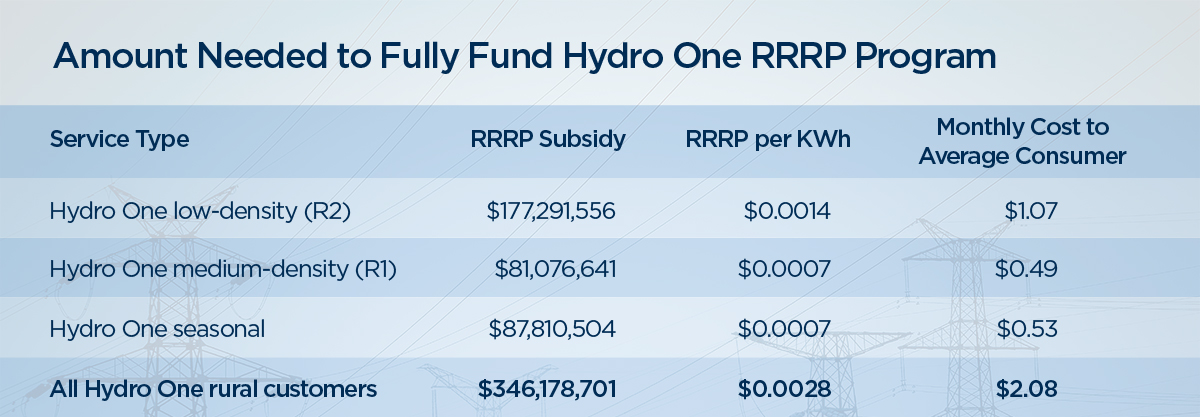Ontario’s energy minister, Glenn Thibeault, is refusing to release government estimates for the cost of subsidizing rural electricity rates in Ontario.

A document obtained by Global News through Ontario’s Freedom of Information Act, reveals that Thibeault was briefed earlier this summer on the costs of enhancing the province’s Rural or Remote Rate Protection program (RRRP) to fully subsidize distribution fees for Hydro One customers. If adopted, the subsidy would adjust current rates so that distribution fees paid by rural and non-rural customers would be “comparable” to one another, according to the briefing note.
The document itself contains details on the total number of Hydro One rural and non-rural customers, the difference between the rates each type of customer currently pays, as well as the total amount needed to cover the distribution fee subsidy.
READ MORE: Angry rural Ontario hydro customers stage protest over rising costs
However, important details of this analysis, like what category of customer might benefit, how much each customer would receive, and the total cost of the subsidies themselves were either redacted or entirely removed from the document.
Asked why these sections were excluded, the ministry’s information officer responded that the release of such information would, “permit one to draw an accurate inference about a policy option (advice to government) being considered in relation to the Rural or Remote Rate Protection” program.
Global News has since made numerous attempts to contact the minister and his staff in order to obtain an unredacted version of the government briefing note. As of yet all calls and emails on this subject to the ministry have gone unanswered.
- Life in the forest: How Stanley Park’s longest resident survived a changing landscape
- ‘Love at first sight’: Snow leopard at Toronto Zoo pregnant for 1st time
- Carbon rebate labelling in bank deposits fuelling confusion, minister says
- Buzz kill? Gen Z less interested in coffee than older Canadians, survey shows
Today, during a press conference held in Toronto, Thibeault again refused to release the information, adding that he has received many briefings on the subject and is working diligently to provide assistance and relief to more than 330,000 rural electricity customers in the province.
Thibeault then added that a number of different options are currently being discussed within the ministry and are before the OEB. He said he still has many briefings on the subject and will continue to look at ways of reducing costs for Ontario ratepayers.
How much would the subsidies really cost?
Using information obtained from Hydro One and the Ontario Energy Board, the organization responsible for regulating the province’s energy sector, Global News has come up with estimates of its own for the cost of equalizing distribution rates between Hydro One rural and non-rural customers – essentially, creating a single, per kilowatt-hour rate for all Hydro One customers in the province.
At present, Hydro One urban-density customers pay roughly 18.5 cents per KWh. While low-density customers, those living in rural or remote regions of the company’s service area, pay roughly 22 cents per KWh. The total amount needed to make up the difference between these rates – the subsidy – is roughly $177 million a year.
Distributed across all electricity customers in Ontario, as are all amounts paid out through the RRRP, this figure would add an additional $1.07 to average monthly bills of residential consumers in the province. This is on top of the roughly $1 per month residential customers in Ontario already pay to support the RRRP subsidy.
READ MORE: Waking up to a crisis: Ont. Liberals late to game when it came to soaring hydro bill
The resulting subsidy, delivered through the RRRP, would save Hydro One low-density customers approximately $500 a year.
“It’s an option that needs to be investigated,” said Theresa McClenaghan, executive director of the Canadian Environmental Law Association and co-founder of Ontario’s Low Income Energy Network. “Some people are low-income, some people have electric heat. We have to really take a look at the impact of decisions and have a program that’s fair for everyone.”
If distribution rate subsidies were expanded to include Hydro One medium-density customers, something the government has not yet discussed, an additional charge of 49 cents a month would be added to the electricity bills of average consumers. This figure would translate into roughly $150 in annual savings for eligible medium-density customers.
The total amount needed to make up the difference between what urban customers currently pay for distribution fees and what medium and low-density customers pay is approximately $250 million a year – or an average monthly surcharge of $1.56 for every residential customer in the province.
“What’s really important is that these energy cost decisions be made in ways that we take account of the impact on all the categories of ratepayers,” said McClenaghan. “What we need is a really clear and transparent conversation in the province among all decision makers as well as the public.”
Not all experts agree
While the government has not released information on the cost of expanding the distribution subsidy program to cover all Hydro One rural customers, there are some energy experts that believe using ratepayer-funded initiatives like the RRRP to fund subsidies for other ratepayers – even those with higher monthly bills – is the wrong approach.
Brady Yauch, executive director and economist at the Consumer Policy Institute based out of Toronto believes that if the government ever were to institute such a policy, it should be funded through tax dollars as opposed to using ratepayers to prop up the costs of other consumers.
“In general, we’re opposed to using ratepayers to subsidize other ratepayers,” said Yauch. “Costs, particularly for rural ratepayers are high, too high, and it’s causing all sorts of problems with people struggling to pay their bills, but if it’s a social problem, and if it is then the government should step in, through taxes, and pay for it.”
Yauch points to other problems with such programs. In particular, the disincentive it creates for other utility providers to keep rates low if they know higher rates will simply be subsidized through ratepayer-funded initiatives.
“If you’re a utility in Ontario that’s not Hydro One and you’ve managed to keep your rate increases low, or reasonable,” said Yauch. “Well, you’re now essentially being punished, or you’re punishing your customers because Hydro One has been unable to do that.”
How the RRRP works
The Rural or Remote Rate Protection plan is an existing government program that subsidizes the cost of electricity for the province’s most rural customers.
The money needed to fund the RRRP is collected by adding a surcharge to every KWh of electricity sold in Ontario. For 2015 and 2016, the RRRP surcharge was fixed at 0.13 cents per KWh of electricity or roughly $1 a month for average residential customers.
The amount distributed through the RRRP each year is roughly $174 million. These funds are divided between Hydro One low-density customers, Hydro One Remove Communities customers, Algoma Power customers and residents of three First Nations groups in James Bay.
Government estimates on the cost of further subsidizing distribution fees for Hydro One rural customers, such as those described in the minister’s briefing note, will be achieved by increasing subsidies already delivered through the RRRP.






Comments